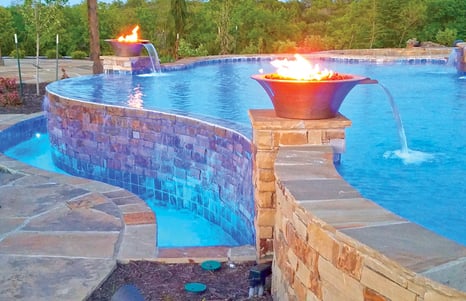—Sophisticated ways to add beauty and functionality to big-ticket renovations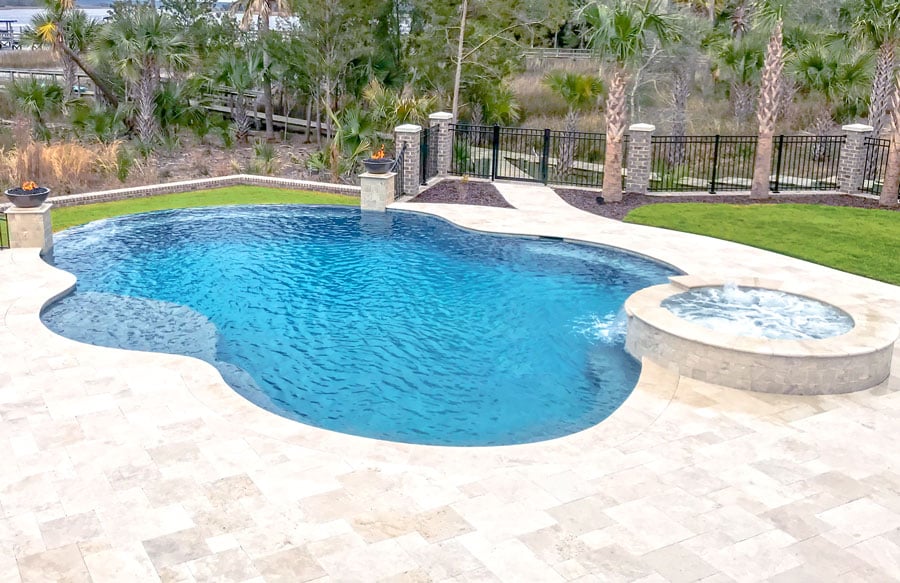
Are you planning an upscale, complex swimming pool renovation?
By integrating a stunning fire bowl, lovely water feature, or relaxing tanning ledge, you can modernize your backyard retreat and take it to the next level of style and functionality.
Adding these remodel upgrades fall within the realm and expertise of many pool contractors. However, your chosen professional may not necessarily offer them to you as an option.
Often, they have good reasons why. These remodel options require multiple construction phases with price tags that soar beyond many pool owners’ project budget.
For a new pool, including these options is easier and more affordable. But on a pool makeover, it’s a different case: Certain factors come into play and make these additions more or less practical from a cost perspective.
Let’s look at some possibilities for a high-end pool renovation. We will explain the required construction phases, and we will point out considerations that help you manage expenses.
By understanding what the project entails, you will be better positioned to consider your budget and to discuss potential options with your contractor.
Building a tanning ledge during a pool remodel
Tanning ledges may not be the visual stunners that fire or water features are, but they deliver a huge win for practicality and convenience.
Popularized at luxury hotel resorts, tanning ledges are solid spans inside the pool perimeter that resemble wide, shallow steps or benches.
Based on the size and configuration of your pool, various shapes are possible.
Also called “sun shelves” or “Baja benches,” these structures typically run about 4 to 10 feet in length, several feet wide, and 3 to 18 inches deep.
These dimensions, coupled with their shallow depth, make them ideal for lying directly in the water without fully emerging your body.
Those built a foot or more deep and 8 feet or longer work well for setting out one or several chaise lounge chairs. Many incorporate a large patio umbrella to provide some shade.
You can also use these submerged perches as a supervised play area for small children.
Ditto for a pet pooch who enjoys cooling off in a few inches of water, but without having to swim in deeper sections of the pool.
 A popular tactic with a tanning ledge is to include a colorful patio umbrella to provide shade.
A popular tactic with a tanning ledge is to include a colorful patio umbrella to provide shade.
Construction process and considerations
Now, as a project line-item, let’s be frank: Adding a tanning ledge is a high-end proposition.
This project will require a complete new plaster job as one portion of the construction. So it’s hardly worth adding this feature unless new interior finish is already slated for your remodel!
Now, if a fresh coat of plaster is on the agenda, it might be worth considering this feature. However, in addition to plastering, know that a tanning ledge will require other construction phases and accompanying costs.
Here’s what’s involved.
After the remodel crew chips out your pool’s existing plaster, another team of specialists will start on the tanning ledge.
Just as they do when building a new gunite pool, a crew of steel installers will place a carefully formed frame of reinforcing rebar for the ledge.
Once the steel rods are in place, a whole other team will come in with a full concrete pumping rig. They will shoot gunite or shotcrete material onto the steel-bar frame to create the solid tanning ledge.
Does the plan call for a patio umbrella in your ledge? If so, before applying gunite, the crew will place a sleeve form in the structure. Doing so will create a place for inserting an umbrella pole.
Finally, the plaster crew will come on board. They will finish the ledge by applying a gleaming new coat of marcite, quartz, or pebble material to the rest of the pool interior.
When tile or decorative stone is part of a tanning ledge’s design, another specialty team will cover the plastered ledge with your material selection.
(To learn more in-depth information, check out this article: adding a tanning shelf to an existing pool during a remodel. It provides additional construction details as well as design options.)
If you can pull off this resort-style addition during your pool remodel, the new tanning ledge will provide added ease, comfort, and functionality for backyard leisure.
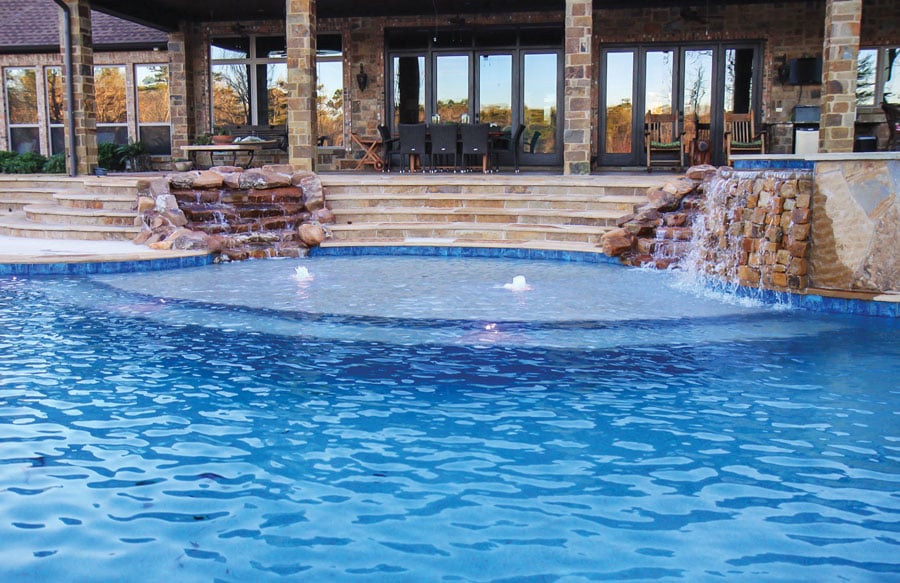 One way to create a tanning ledge is to enlarge the first entry step to create what’s called an “extended step.”
One way to create a tanning ledge is to enlarge the first entry step to create what’s called an “extended step.”
Adding fire bowls to an existing pool
Who says fire and water don’t mix?
Consider elevating your swimming pool style with a stunning fire bowl. These fire features add exciting flair to any pool and patio setting.
Concrete fire bowls are prefabricated, shallow vessels that are typically round or square. Prefabricated designs measure anywhere from 24 to 48 inches across. You can also splurge for a custom size, shape, or style of fire feature.
Most fire features are installed with a line for propane or natural gas. The line connects to an igniter mechanism for fueling the fire.
Some installations are manual, but the smart approach is to invest in convenience. You can control the flame intensity with a handy remote device or integrate them into your pool automation/control system.
Construction process and considerations
Is your heart set on having one or more of these mesmerizing fire features in your outdoor space?
Understand that integrating one into your existing pool will entail several installation phases. Take note: If you are choosing a combo fire-water bowl, an additional step is required.
In fact, the addition of either a fire bowl or fire-water bowl will most likely be impractical unless one of the following applies to your remodel plans.
Note: These scenarios also apply for adding most water features.
A. Your existing pool deck is composed of either paver stones or concrete with an acrylic or spray deck coating, such as Sundek® or Kool Deck®; OR
B. You have an existing concrete deck, and your planned remodel will include either retexturing, resurfacing, or recoloring it; OR
C. Your planned remodel will include the removal of your existing deck (any material) and the installation of a new deck or other ground covering (e.g., loose stones, a faux or natural grass lawn), OR
D. The space between your desired fire bowl(s) (or certain water feature) location and an existing gas or electric line contains either:
• Open ground—soil with no permanent deck/hardscape, OR
• Semi-open ground that’s partially covered with small plantings, light landscaping, or loose stone-scaping that’s easily removed and later restored.
Repeat: Your project should involve one of these four scenarios! Otherwise, the already considerable cost will be even higher. Read on to understand the reasons.
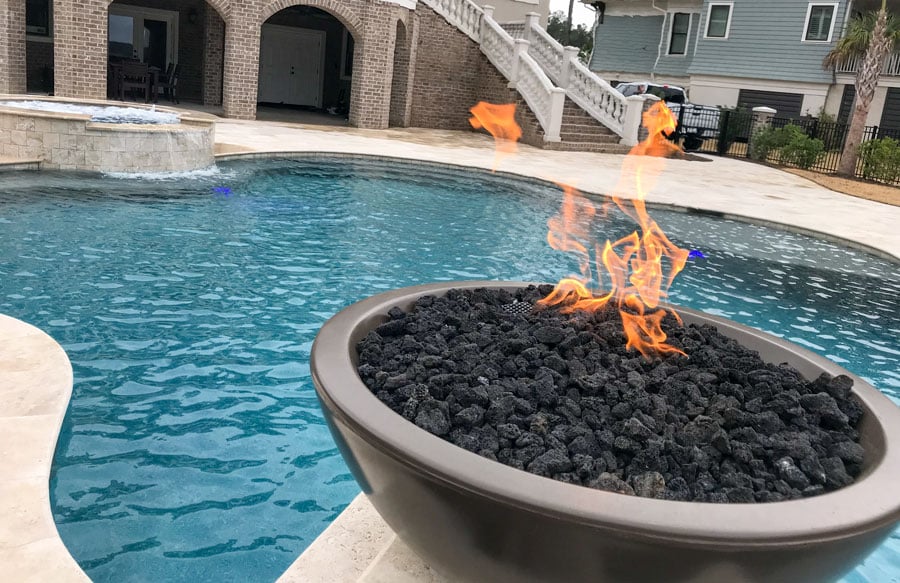 Dancing flames in a fire bowl adds visual intrigue to any backyard setting.
Dancing flames in a fire bowl adds visual intrigue to any backyard setting.
Why these factors matter:
Say your existing pool or scope of remodel does not meet one of the four scenarios described above.
To install the needed infrastructure for a fire bowl (or most water features), damage to your deck is usually unavoidable.
The reason: Your contractor must connect certain utility lines—such as gas or electric—to power the fire bowl. (Or, in the case of a water feature, a plumbing line). Those lines need to go underground.
If you want a remote control for the fire bowl, having one will also require a line of conduit running from the feature to the electric line over at the pool equipment area in your yard.
(For a water feature with LED lighting, a line for electric conduit will always be needed.)
One exception: A manually operated, gas-powered fire bowl—vs. one you can activate by remote control—does not require a line for electrical conduit.
So if the bowl location happens to be near an existing gas line, you may be able to circumvent deck removal.
If an existing solid deck—whether wood, concrete, or stone installed with mortar joints that form a unified structure—is blocking access to the ground, how will anyone dig a trench to bury utility lines?
The answer is that a masonry crew will have to saw cut or even jackhammer through a section of deck to reach the earth. After all, no one would want to destroy a perfectly good deck.
That’s why the kind of current hardscape you have or your remodel plans for new decking or ground cover will make all the difference.
If you have a paver deck, that’s good news; this process is simple: Your remodeler can remove just enough pavers to dig a trench, install the utility lines, backfill it, and then restore your deck to original by putting the same pavers back in place.
If you have a concrete deck topped with a decorative finish, you probably have an obstacle that can be overcome with moderate effort and cost. Your builder will need to cut through the concrete, dig the trench, and install the lines.
Then, they will pour a small amount of fresh concrete to fill in the section that was cut out. However, now a fresh deck topping will be needed.
So, if you are already planning to resurface your entire deck—the total square footage—to freshen up its appearance, that’s the ideal scenario for adding a fire bowl (or water feature).
Or, suppose the plan is to rip out existing deck and put in a new one? Or to replace it with fresh landscaping?
Then you are also good to go: Access for digging a trench will be completely clear, and it’s all smooth sailing to lay the needed utility lines.
Ditto if your pool’s configuration will allow for a fire bowl to go near existing gas and electric lines, and if the short span of ground that’s needed for a trench is already open and generally accessible. (For water features, this applies as well for plumbing lines.)
For example, the ground may be covered only with a few plantings, loose decorative pebbles, or a span of lawn that you can easily remove and replace.
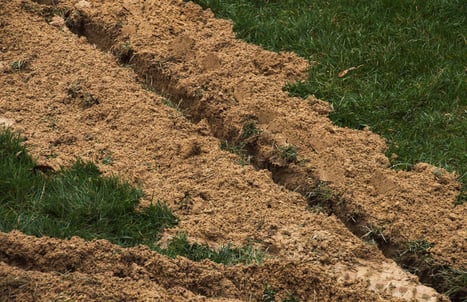 Is all that lies in the way of digging trenches for utility lines a lawn? You are in luck—grass is easy and affordable to replace.
Is all that lies in the way of digging trenches for utility lines a lawn? You are in luck—grass is easy and affordable to replace.
To recap: If your deck type, ground conditions, or remodel project plan do not fall into one of the scenarios outlined here, it is unlikely your pool remodel contractor will have an economical way to install a fire feature (or a water feature).
But perhaps your backyard offers the requisite conditions. If you succeed in accenting your made-over pool with one or several fire bowls, you have a home run.
These features will take your project from a typical pool update to an upscale renovation, elevating your outdoor space.
Adding water features
Both beauty and excitement come with the introduction of water features to a backyard pool.
Several kinds can go on a major pool remodel. Among the most popular are rock waterfalls, cascade falls, and deck jets/laminars.
Perhaps your vision for a pool rejuvenation includes a rock waterfall or an impressive rock grotto. The sight of water flowing over faux or natural stone can help transform a pool into an oasis seemingly kissed by Mother Nature.
Another benefit: Depending on the feature’s size, height, and configuration, it will produce tranquil sounds of falling or gushing water.
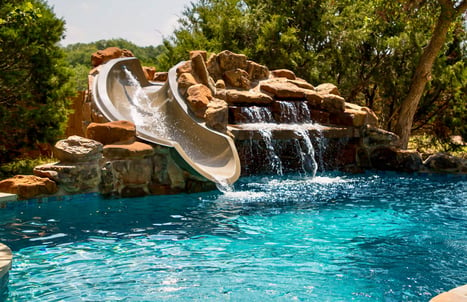 Beneath the water spilling from overhead, pool grotto designs feature a covered area that ranges from a small niche to an entire cave with features like benches and lighting.
Beneath the water spilling from overhead, pool grotto designs feature a covered area that ranges from a small niche to an entire cave with features like benches and lighting.
Or, maybe you prefer the striking effect created by curving deck jets or laminars. These features are set either into the pool deck or the pool’s interior walls, and they shoot thin, arching streams of water onto the pool surface below.
Many adults enjoy the visually pleasing factor these liquid tubes create, and kids can have fun playing in the “dancing water.”
Another favorite water feature is a cascade or “sheer-descent” waterfall. Built into your pool’s perimeter—typically in a bond beam, a raised section of pool wall—these features produce a “sheet” of falling water.
Styles include water descents that are “solid”—smooth and flat. Others break down into a raindrop flow.
Cascades span a range of sizes and configurations. You can have a single feature that spans 12 or 18 inches or several feet. You builder can also install a series of cascades across a swathe of raised beam (a section of pool wall that typically extends 18 inches or higher above the pool surface.)
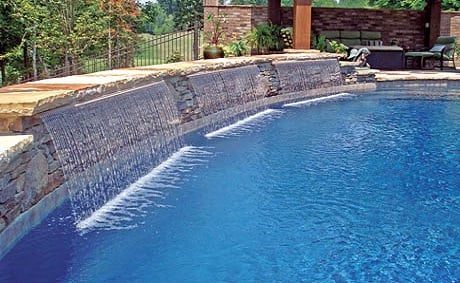 Cascade water features come in a variety of widths, making them a versatile options for many pools that have raised bond beam.
Cascade water features come in a variety of widths, making them a versatile options for many pools that have raised bond beam.
A newer pool-design trend for water features is a scupper. Depending on this accessory’s size and shape, it focuses the descending water into a narrow cascade or a round, tube-like flow.
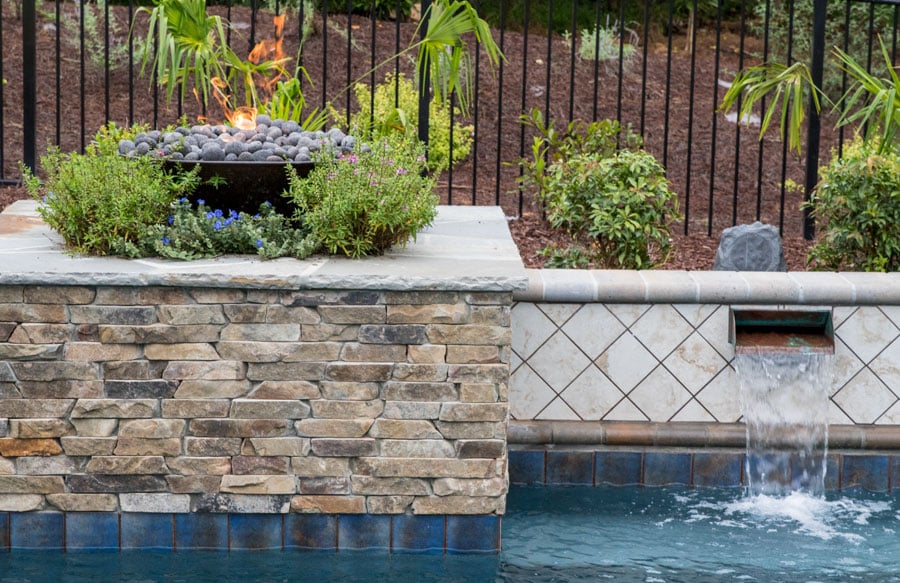 The water takes shape as it flows out of a scupper, creating an intriguing effect.
The water takes shape as it flows out of a scupper, creating an intriguing effect.
Whichever water features you incorporate during a pool remodel, the results are sure to delight. However, know if you “qualify” as a good candidate for this complex addition. Let’s explore this topic next.
Construction process and considerations
As with adding fire features in a pool remodel, specific conditions must exist to justify the effort and expense.
With this in mind, if you skipped the Fire Feature section above, stop here. It’s critical to go scroll up, and read the subsection “Construction process and considerations” above!
Most of the content there applies to water features for remodels. Be sure to confirm that your pool, deck, backyard, or remodel plan meets at least one of the four scenarios outlined—A, B, C, or D.
If none do, you may need to accept the unfortunate reality: Adding a water feature during your pool makeover may simply be outside your budget and/or an expense hard to justify.
(To understand more: Under the Fire Feature section, also see the sub-section “Why these factors matter.”)
Now, if—and only if—you case meets scenario A, B, C, or D, then read on here.
Many of the construction efforts needed for adding water features to an existing pool are similar to those for adding fire features.
Any of the water features described above require a plumbing line to feed them. In most cases, that pipe will require a trench in the ground to protect it and keep it out of sight.
Now, will your pool contractor be digging a trench for a gas or electric line for another pool-remodel purpose or backyard amenity, such as a new fire feature, grill, outdoor speakers, or patio lighting?
If so, they can likely use this same space and piggyback into it the plumbing pipe; that shared arrangement effectively cuts installation costs a bit.
Yes, water feature additions are a big-ticket item. However, the investment will pay off with greater liquid drama and a treat for both your eyes and ears!
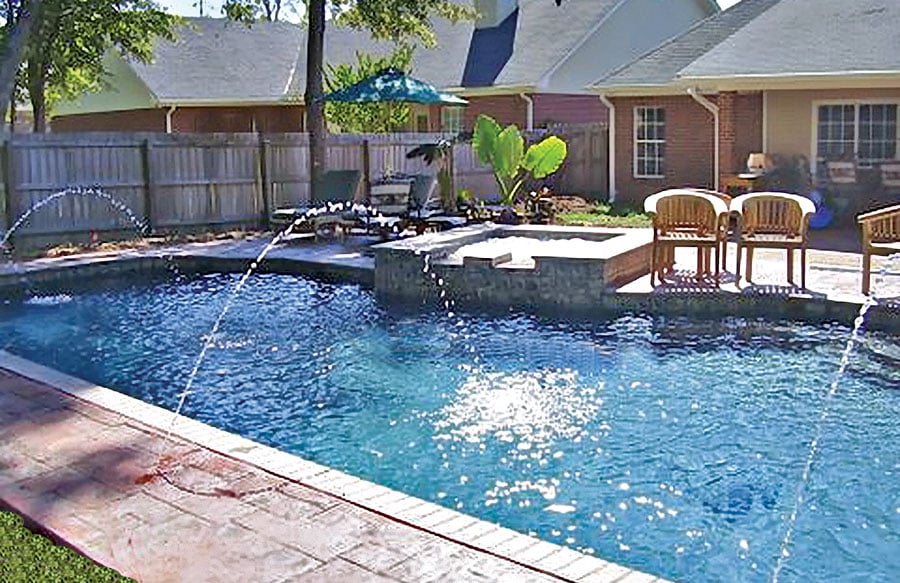 With their sleek, glasslike form, a set of laminar water features create a graceful attraction on any pool.
With their sleek, glasslike form, a set of laminar water features create a graceful attraction on any pool.
Manage expenses on complex pool remodels
A great deal goes into the construction effort and building materials to add one of these great features to an existing pool. That means the benefits come with certain price tags.
So when it’s time to give your pool a facelift, begin planning your budget. Know how much you can invest.
Then, consider if your makeover will include new plaster or a deck rehab that will impacts the final cost of one or more of the three upgrades discussed here.
Adding one or more of these popular features to your pool can pay off with enhanced beauty and functionality.
Keep in mind that some options for updating an aging pool and its equipment will also pay off with energy and water savings, which help defray ongoing operational costs.
A fire or water feature or tanning ledge will bring greater dimension and sophistication to your pool, as well as new ways for your family to make the most of it.




.jpg?width=1490&name=rock-waterfall-slide-pool%20(1).jpg)
